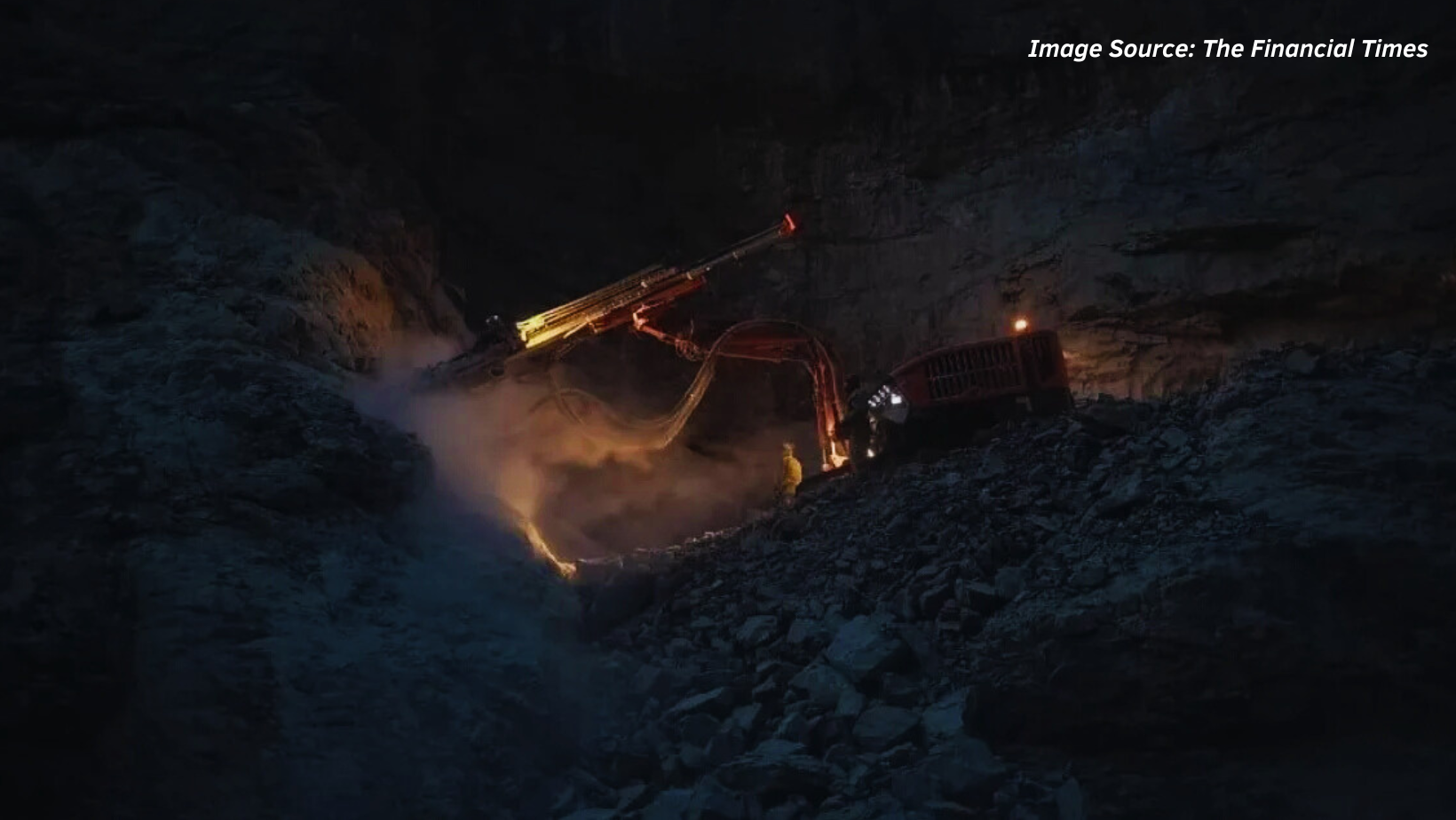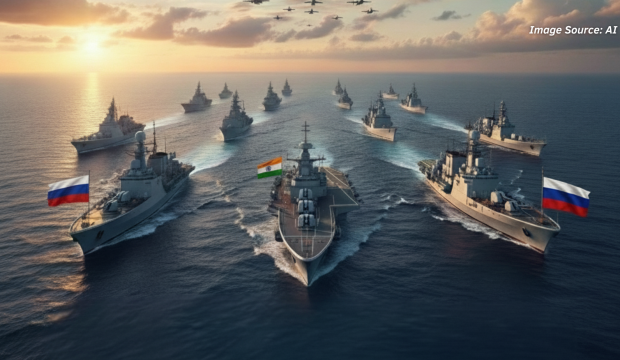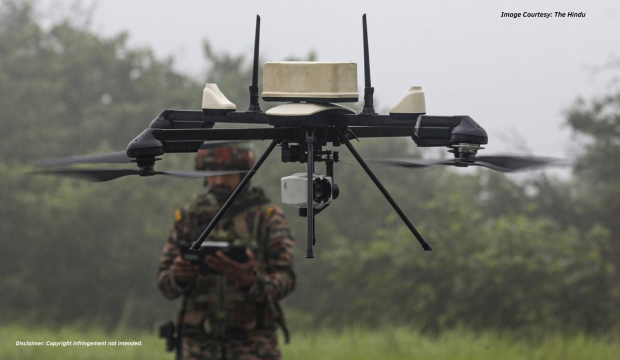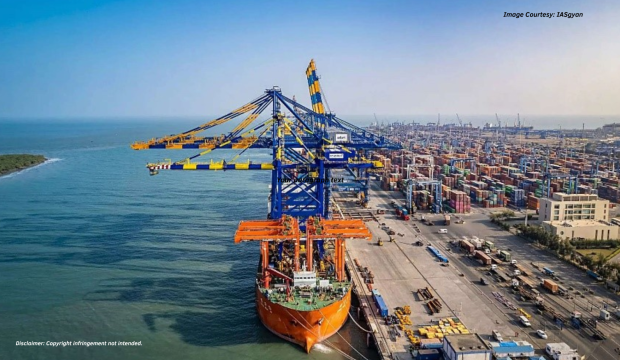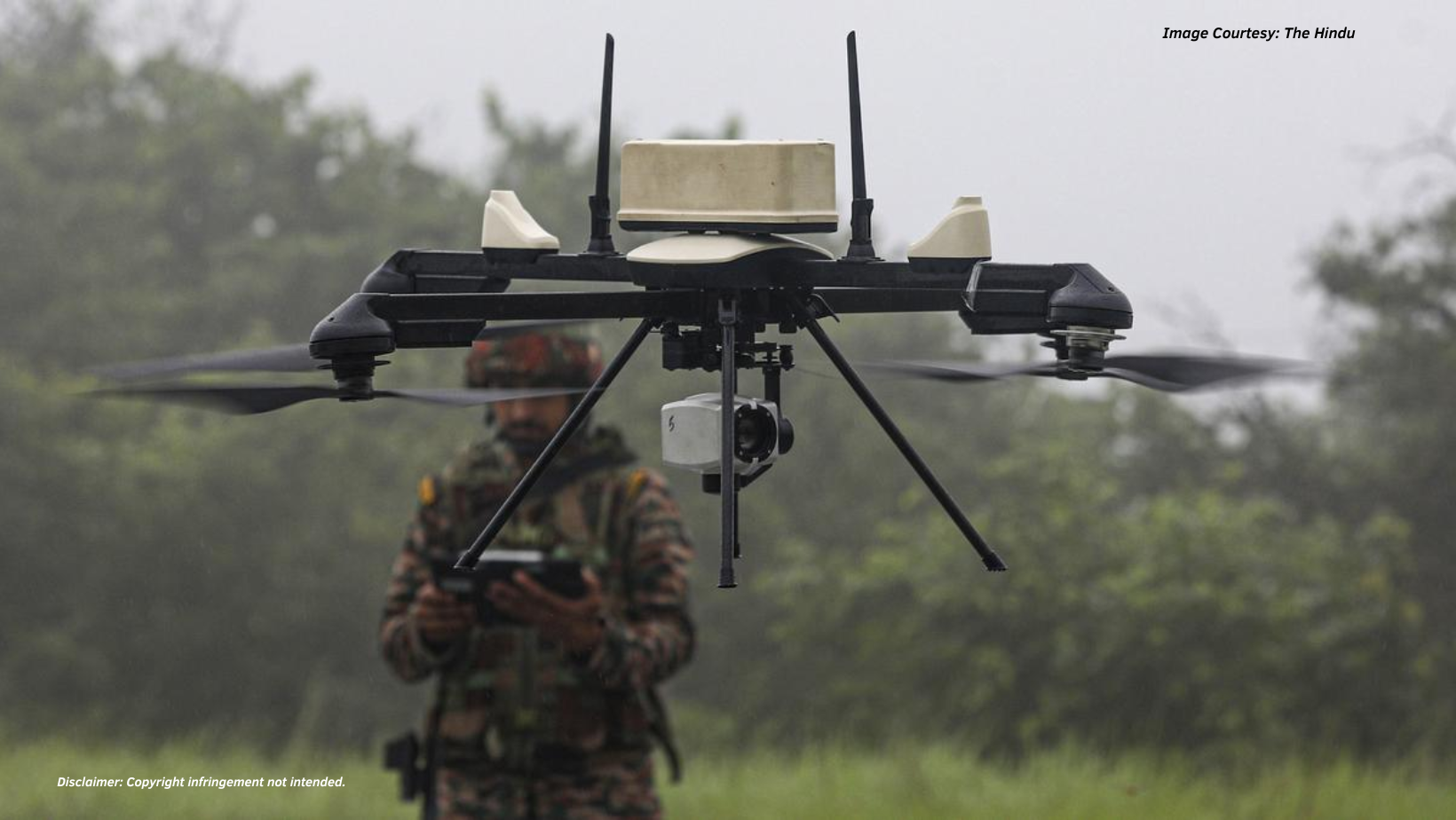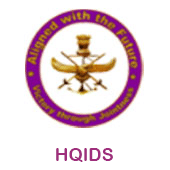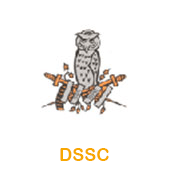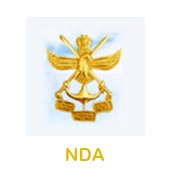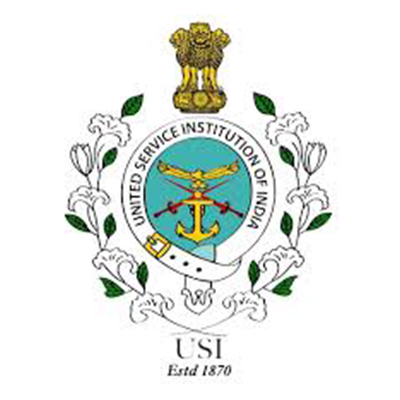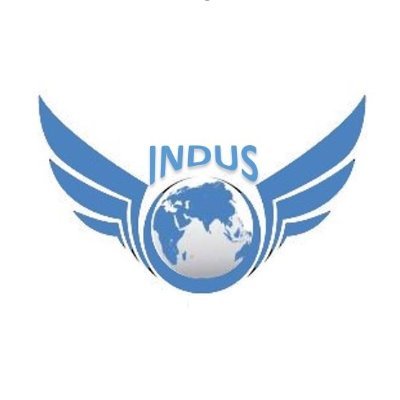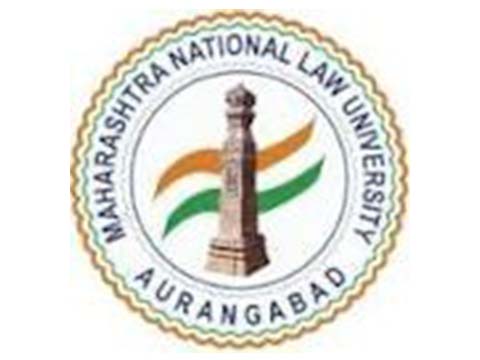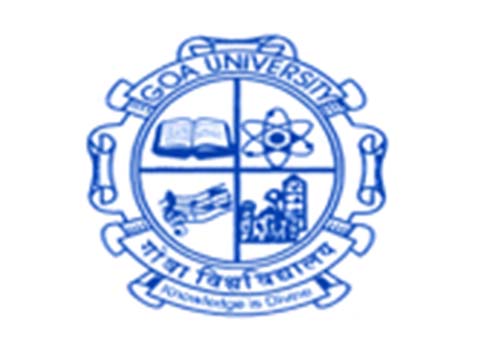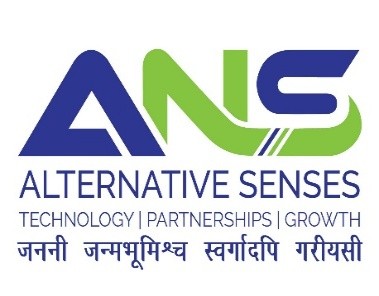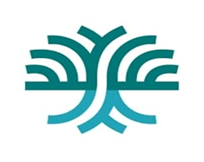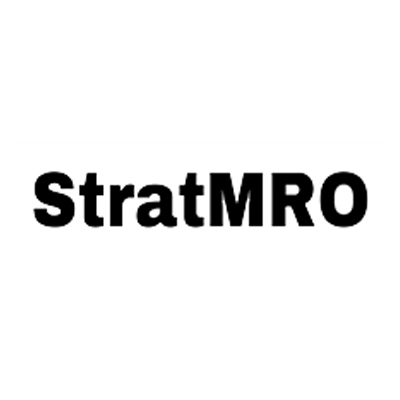Abstract
The geopolitical global landscape is transforming rapidly due to increasing tensions in Eastern Europe and Middle East. Sooner or later it is certainly going to spread eastward to South China Sea thereby activating Indian Ocean as future hotspot for China and United States jostling in the power game. India has to gear up its doctrines, force structures and war fighting capabilities to meet challenges of backlash of such conflicts by guarding its maritime and land borders strongly. China has tested Indian responses through local skirmishes at Dokala, Galwan and Yangtse1 during last seven years with a view to provoke India to take such local conflicts to next higher levels. India and China both have significant military capabilities and are positioned strategically along the Himalayan frontier. Given the rising tensions and the potential for conflict, it is imperative to understand how the Indian Armed Forces along with its other essential components could effectively engage in joint warfighting operations against China. This paper explores the niche technologies in use and which more can be infused by Border Roads Organisation (BRO) to optimise the potential of our war fighting mechanism.
Rapidly evolving technologies are changing the character of warfare2, and we are yet to understand the impact of these changes. Adapting to this evolving landscape requires the joint force to integrate capabilities and synchronize effects fluidly across all domains. The opportunity for the Joint Force, as it looks ahead to a future still unclear by the long term impact of rapid changes, is to get ready for the warfare of the future.
India is rapidly moving towards theaterisation of its regional commands3 to subsequently enunciate its Joint War-fighting Concept & Doctrine (JWCD). JWCD will act like a beacon for integration of Armed Forces with industry and other components to support the joint war-fighting effort and would offer a shared vision of the terrain and common destination. In this complete process, BRO is going to play a bigger role by creating a robust infrastructure network to enable the Joint Force extend its reach, options to manoeuvre and strike designated targets with increased accuracy and impunity. It would be BRO’s endeavour to maximise the strength of Joint War – fighting mechanism during critical combat situations.
Introduction
The geopolitical global landscape is transforming rapidly due to increasing tensions in Eastern Europe and Middle East. Sooner or later it is certainly going to spread eastward to South China Sea thereby activating Indian Ocean as future hotspot for China and United States jostling in the power game. India has to gear up its doctrines, force structures and war fighting capabilities to meet challenges of backlash of such conflicts by guarding its maritime and land borders strongly. China has tested Indian responses through local skirmishes at Dokala, Galwan and Yangtse1 during last seven years with a view to provoke India to take such local conflicts to next higher levels. India and China both have significant military capabilities and are positioned strategically along the Himalayan frontier. Given the rising tensions and the potential for conflict, it is imperative to understand how the Indian Armed Forces along with its other essential components could effectively engage in joint warfighting operations against China. This paper explores the niche technologies in use and which more can be infused by Border Roads Organisation (BRO) to optimise the potential of our war fighting mechanism.
Rapidly evolving technologies are changing the character of warfare2, and we are yet to understand the impact of these changes. Adapting to this evolving landscape requires the joint force to integrate capabilities and synchronize effects fluidly across all domains. The opportunity for the Joint Force, as it looks ahead to a future still unclear by the long term impact of rapid changes, is to get ready for the warfare of the future.
India is rapidly moving towards theaterisation of its regional commands3 to subsequently enunciate its Joint War-fighting Concept & Doctrine (JWCD). JWCD will act like a beacon for integration of Armed Forces with industry and other components to support the joint war-fighting effort and would offer a shared vision of the terrain and common destination. In this complete process, BRO is going to play a bigger role by creating a robust infrastructure network to enable the Joint Force extend its reach, options to manoeuvre and strike designated targets with increased accuracy and impunity. It would be BRO’s endeavour to maximise the strength of Joint War – fighting mechanism during critical combat situations.
Strategic Context
The 1962 Sino-Indian War and subsequent skirmishes along Line of Actual Control (LAC), underscore the volatility of our Northern frontier. China’s infrastructural development in Tibet, including roadways, railways and airbases started much before India raised BRO in 1960 with two projects deployed in Srinagar and Tezpur to develop strategic roads in J&K and Arunachal Pradesh, crucial for the rapid mobilization of troops and military equipment.4 China has been focused and consistent in enhancing this infrastructure considerably all along the LAC, whereas India lagged behind due to its regressive strategic thinking and provision of meagre funds for connecting its posts right upto LAC.
Force Multiplication through Infrastructure
In modern warfare, infrastructure acts as a force multiplier. The BRO’s efforts in constructing and upgrading road networks not only facilitate the movement of military personnel and equipment but also support the establishment of advanced bases and logistics hubs.5 These infrastructures serve as staging areas for joint operations involving the Indian Army, Air Force, and other paramilitary forces.
For instance, the development of roads leading to forward airbases allows for the quick transportation of fuel, ammunition, and other critical supplies, ensuring that air operations can be sustained for longer periods. In the event of a conflict with China, the ability to sustain prolonged air operations and provide air support to ground troops can be a decisive factor in achieving military objectives. In addition, vital inputs are also taken from the respective state administrations while planning all projects so as to factor in the local socio-economic requirements and internal security compulsive concerns.
Building Construction Synergy in Armed Forces
The BRO’s infrastructure projects also foster synergy between various branches of the armed forces. The coordination required for the construction and maintenance of roads and bridges in challenging terrains necessitates close collaboration between the BRO, the Indian Army Corps of Engineers, and other defence agencies. This collaboration ensures that all branches of the military are familiar with the infrastructure capabilities of BRO available to them.
Moreover, the BRO’s projects have been using advanced engineering techniques and technologies during past few years to accelerate the work pace, which provide valuable learning opportunities for military engineers. The experience gained from these projects enhances the technical and operational expertise of the armed forces, contributing to their overall war-fighting capabilities.
Psychological and Strategic Significance
The development of strong infrastructure on our borders has a psychological and strategic impact on both our forces and the adversary. For our troops deployed in remote and difficult areas, the availability of extensive road matrix boosts morale and ensures better logistics lines, medical evacuation routes and communication links. This logistical assurance is crucial for ensuring the effective readiness of troops in critical combat situations.
On the other hand, the development of infrastructure on our inhospitable Northern Borders sends a strong message to adversaries like China about India’s steadfastness to defend its territorial integrity. Accelerated pace of work by BRO on our borders post Galwan conflict has sent a strong signal to China dissuading it to avoid any misadventure with India.6
Incremental budgetary support over the last four years, infusion of new technologies and products besides the latest equipment and machines, worked like a magic potion in consuming Rs 45238 Cr in the past four years vis-a-vis Rs 45,194 Cr which was spent in nine years of pre-Galwan period.7
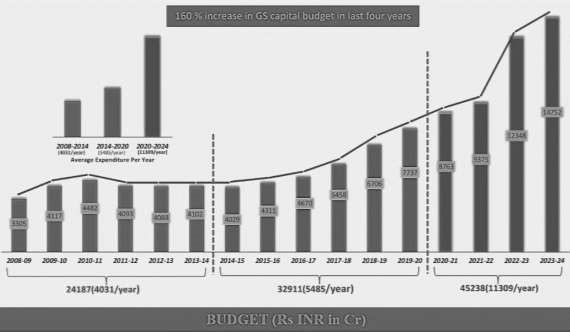
Challenges and Future Prospects
BRO while ensuring last mile connectivity on our Northern Borders has been braving the challenges of the harsh and often unpredictable weather conditions, coupled with difficult terrains. Additionally, budgetary constraints and bureaucratic hurdles can also impede the timely completion of projects.
Looking ahead, the BRO’s role is expected to become even more critical as geopolitical tensions with China persist. The ongoing strategically important border infrastructure projects, are set to further bolster India’s defensive and offensive capabilities. Additionally, the BRO’s involvement in the development of dual-use infrastructure, which can serve both civilian and military purposes, will enhance the overall strategic depth and resilience of India’s border regions.
Modernisation of BRO post Galwan
New and emerging technologies are redefining the methodology of road construction with a transformed focus on sustainable development. Technological advancements made in this area have quickened the speed of construction and lowered the project lifecycle costs.8 Some of the areas of modernisation and use of new technologies/equipment and innovative ideas by the BRO, specifically adopted and introduced post Galwan conflict, have been deliberated upon in subsequent paragraphs.
- Digitisation and Automation. BRO is first Govt department and presumably the only one to digitize all its roads and put it on Geographic Information System (GIS) for ease of better future planning and integration with other ministries working in the same domain. Almost all roads except few have also been uploaded on ‘Gati Shakti Sanchar Portal’ to ensure that all departments have visibility of each other’s activities providing critical data for planning and execution of their projects in an absolute manner. By doing this, different departments will be able to prioritize smooth and optimal execution of their projects. Also, through use of 11 new software, specifically created to meet BRO’s ground requirements, executives and staff are in better position to monitor progress of all its projects deployed in 11 states and 3 UTs.
- Fixing Alignments. BRO has already started use of drones and Light Detection and Ranging (LiDAR) for preparation of the DPRs for its road projects. With the advent of high-resolution satellite imagery, BRO can conduct detailed topographical assessments with unparalleled precision.9 This data forms the foundation for designing routes that are not only cost-effective but also minimize environmental disruption. The imagery can reveal potential geological hazards, allowing BRO to proactively design mitigation strategies, which is particularly crucial in areas prone to landslides and earthquakes and prevent crucial disasters akin to Silkyara tunnel in Uttarakhand.
- Monitoring Construction Progress. BRO has already projected its demand for a dedicated LEO Satellite for pseudo real-time multi-sensor data acquisition for road alignment and earth work requirement planning to support the preparation of Detail Project Report (DPR) along with support to track ground-based assets in remote locations.10 Satellite imagery can be used to monitor the progress of road construction in remote areas, providing real-time updates and helping in better project management. This not only ensures adherence to timelines but also allows for the rapid reallocation of resources to areas where progress may be lagging or where unforeseen challenges have arisen.
- Satellite Communications. Operating in the world’s most isolated regions, BRO utilizes satellite phone communication to forge dependable connections between its ground teams and the Headquarters. Sufficient satellite phones have been procured for its remotely located detachments working on formation cutting and snow clearing tasks.
- Geocells in Sub Base/Base Courses. During last 3-4 years, BRO has come out of its old mindset and experimented with new materials to stabilize pavement structures by using many new stabilization techniques that improve pavement structural strength and reduce repair and maintenance by using on-site or recycled materials. Geocells have proved to be one of the latest stabilization techniques for sub-grade improvement and base reinforcement. These are three-dimensional honeycombed cellular structures made with polymeric materials such as High Density Polyethylene (HDPE) that form a confinement system when in-filled with compacted soil or aggregates.11 In many stretches of BRO roads, Geocells have increasingly been used to increase bearing capacity of sub base and base courses.
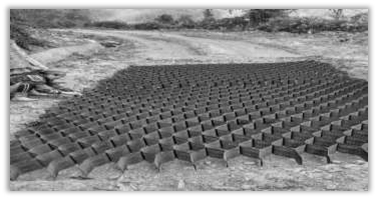
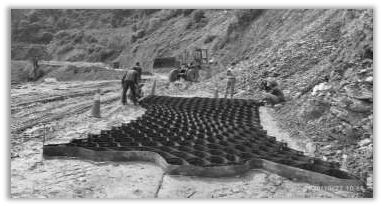

- Cementitious Sub-Base/Base Courses. For road bases, there are a variety of soils or granular materials available for construction, but they may exhibit insufficient properties (e.g. low bearing capacity and susceptibility to frost action), which then results in substantial pavement distress and reduction of the pavement life. However, addition of a stabilizing agent can improve the properties of soil. Among all these stabilizing materials, cement-bound agents show quite high stiffness and strength values, and display good performance for serviceability and durability for pavements.12 Construction of large number of roads post Galwan has been undertaken by BRO in Ladakh, Uttarakhand, Sikkim and Arunachal Pradesh using this technology.

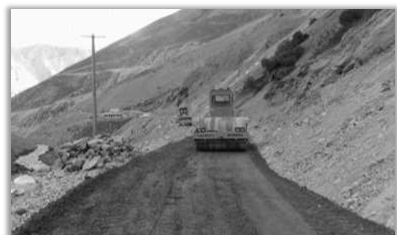
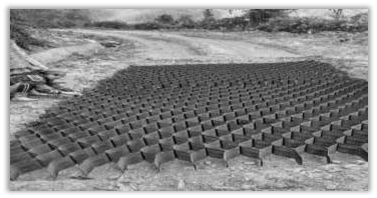
Slope Stabilisation to Mitigate Landslides. The biggest challenge during construction of mountain roads are the fragile hill/valley side slopes created during formation cutting, which come down due to their own weight or get weakened during rains thereby causing considerable damage to roads, bridges and allied structures. Slope stabilisation refers to any implemented technique that aims to stabilize an unstable or inadequately stable slope through use of pre–stressed anchors, rock bolts, piles, soil nailing geosynthetics reinforcement, retaining wall, shotcrete etc.13
A considered decision was taken by DGBR in 2022 to include slope stabilisation in the original scope of road construction as part of the DPR, in order to minimise damage to roads during rains and also to protect the fragile ecosystem as a major preventive measure at places where BRO is constructing roads.
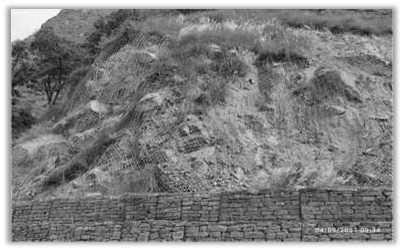
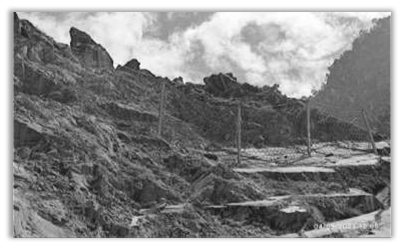
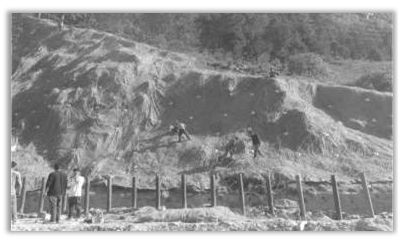
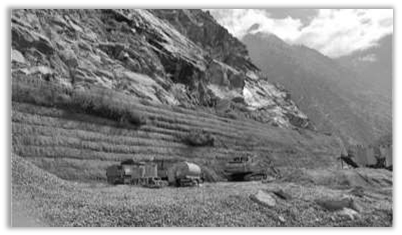
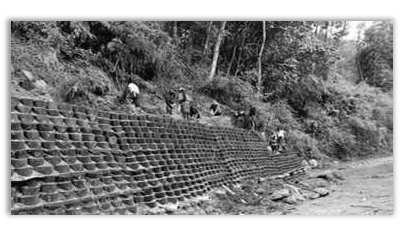
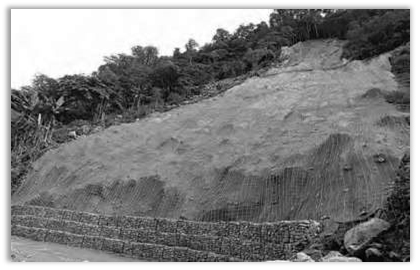
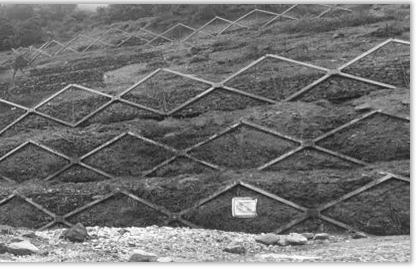

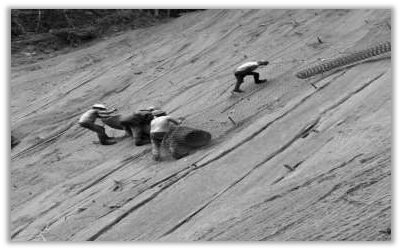
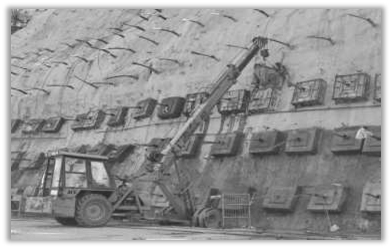
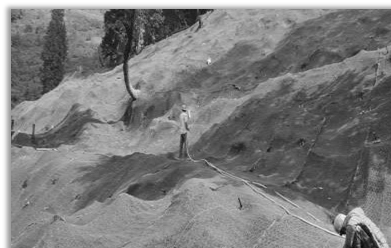

- Avalanche Protection Structures. Avalanche protection structures considerably downscale the risk to life and property posed by avalanches. Road from Palchan to South Portal of Atal tunnel experiences heavy snow fall14. To make this axis all-weather road, avalanche protection structures have been provided by BRO. Many such snow protection structures have been constructed by BRO on road leading to South Portal of Atal Tunnel.
- Snow Erodox. The Snow Erodox is low cost, light, easy and fast to install structure with low environmental impact and can withstand dynamic impacts (rock/ice falls).
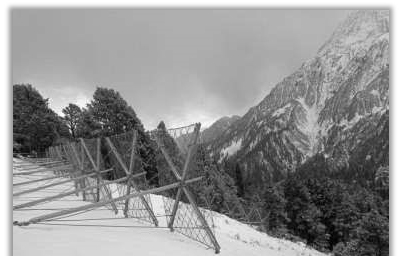
- Snow Galleries. Snow Galleries are direct defense measures for roads or highways in the middle zone of avalanches where snow removal becomes almost impossible.
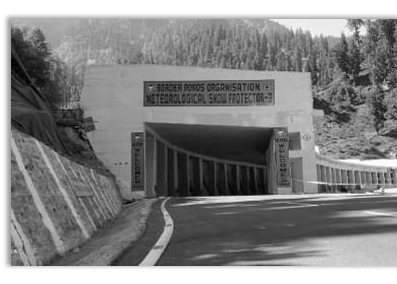
- Geosynthetic Cementitious Composite Mat. Geosynthetic Cementitious Composite Mat (GCCM) is a new product, which is mainly used to line small drainage channels. BRO utilized the technology to construct lined drain on Road TCC – Taksing.15
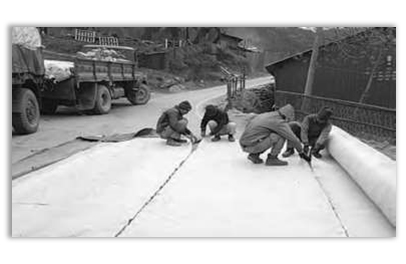
- State-of–the-art Runway Drainage System. There is an essential technical requirement to ensure draining out of surface and subsurface water for the long service life of the airstrip and safety of aircraft. In the runway at Barrackpore, a state-of-the-art sub-surface drainage system has been constructed by BRO. The runway was dedicated to the nation by Hon’ble Raksha Mantri on 12 Sep 23.

- Plastic-Coated Aggregates. Safe disposal of waste plastic continues to be a very serious environmental concern across the globe. As an initiative to reuse the plastic waste, BRO has started using waste plastic extensively in bituminous road construction not only in India but also in Bhutan.16



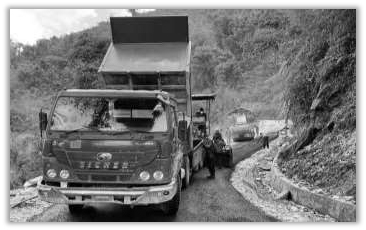

- Inter Locking Concrete Block (ILCB) Pavements. ILCBs are pre casted concrete blocks of varied dimensions and can be interlocked horizontally and vertically as per use. BRO has started using ILCBs since 2021 on pavement of roads at all mountain passes it maintains where heavy snowfall takes place and snow clearance operations by tracked Dozers lead to damage to bituminous layers. The damage caused by snow clearance operations to upper layers of roads leads to interruption in smooth traffic flow and also increases road maintenance cost exponentially. Overall, adoption of this technology will result in considerable cost reduction in construction and cyclic maintenance of roads at mountain passes.17

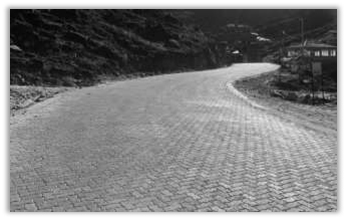
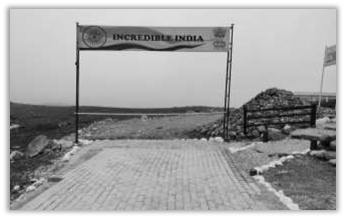
- Precast Concrete Technology (Cut & Fit Technology). BRO is working in one of the most difficult and harsh terrains of the world. These areas typically have very limited working season, completion of road projects in a time bound manner is therefore a huge challenge for BRO. In order to overcome these challenges and fast pace of construction of road, BRO is working on Cut & Fit technique in road construction. To telescope construction activities, all the elements of road are casted at a site ideal for casting process, while the formation cutting is under progress at higher reaches. With this technique, sequential construction is replaced with parallel construction activity to reduce the overall project duration and costs. Lot of work has been done on the pre cast culverts, pavements, reinforced earth walls, drains and breast walls during past few years.18
BRO has executed a pilot project on Along-Yingkiong Road in Arunachal Pradesh in 2022 at Panging with all the pre cast elements i.e. protective structures, culverts, drains and pavements. This technique turns out to be economical, if cyclic maintenance cost and escalation due to typical time over run of conventional road construction is taken into account.
Similarly, it has also been adopted in Ladakh for construction of pre-cast box culverts, which has been found to be extremely useful in speeding up construction and averting/reducing disruptions to traffic. Such culverts can be casted even in winters under suitable conditions when no work is possible at site. Each pre cast culvert is cheaper by approximately Rs 11 Cr as compared to conventionally constructed culvert.
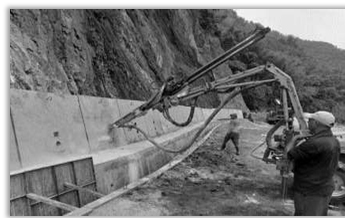

- White Topping Technology. A PCC layer is constructed on top of the existing bituminous layer. This layer imparts additional structural strength during rehabilitation of roads. A pilot project of white topping in BRO has been undertaken successfully at a heavy rainfall area for rehabilitation of road Tuting– Bona in Arunachal.19
- Modular Bridges of Load Class-70. Garden Reach Shipbuilders & Engineers (GRSE) in a Joint Venture with BRO has produced a CL-70R double lane modular bridge at 1/3rdthe cost of imported bridges with similar specifications. One such bridge of span 140 ft was launched on Flag Hill-Dokala road at an altitude of 11000 ft in Feb 2021. In view of cost effectiveness and time saving in construction, BRO and GRSE signed a MoU in March 2022 which was extended for 60 bridges in May 2023.20 More than 30 of these bridges have already been constructed at most critical forward locations. This initiative by BRO will certainly be a game-changer in road infrastructure development in the country making this initiative a major step towards Atmnirbhar Bharat. These prefabricated structures are easy to transport and assemble, significantly reducing construction time and labour costs.

- Cold Mix Asphalt Technology. Cold mix asphalt technology has been a gamechanger for the BRO, especially in remote and high-altitude areas where hot mix plants are not feasible. This technology uses bitumen emulsion at ambient temperatures, which significantly reduces energy consumption and greenhouse gas emissions21. The BRO has utilized cold mix asphalt for constructing and maintaining roads in Ladakh and Arunachal Pradesh, ensuring all-weather connectivity with minimal environmental impact.
- Route Guidance System. In past, BRO used to lose many operators and machines during snow clearance operations over high mountain passes, due to difficulties in estimating the correct road alignment due to heavy snow accumulation. To overcome this, BRO has identified sensor-based Route Guidance System after extensive trials, in which GPS server fed with road alignment data is attached to snow clearance equipment to obtain precise location of the road.22 This has ensured enhanced safety to the operators during snow clearing operations. The equipment has been found to be very effective in identification of the road alignment during snow clearance.

- Use of Steel Slag. A pilot project has been undertaken by BRO on road Joram – Koloriang in Arunachal Pradesh by using steel slag in Nov 2022, which will be able to withstand heavy rains and harsh climatic conditions. The road constructed by use of steel processed slag not only increases the durability but also helps in reducing the cost of construction as slag-based materials have better properties than natural aggregates. This technology will reduce greenhouse gas emissions and in turn carbon footprint in fragile ecosystems where BRO is constructing roads on forward areas. BRO is now working out a long-term logistic arrangement for construction of steel slag roads in strategic areas.23 This initiative taken by BRO has also been lauded by the Hon’ble Prime Minister. Construction cost of steel slag road is 30% less than the conventional road with 3 to 4 times higher strength than the conventional one.
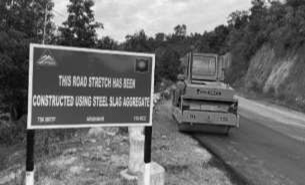
- Carbon Neutral Habitat at Hanle. BRO has taken lead in construction of carbon neutral habitat for its newly inducted Task Force at Hanle to undertake many strategically important projects in Chumar sector.24 Also to enhance induction of men, machines and material at faster rate in Ladakh, BRO has also taken major initiative to undertake construction of 3D printed complex at Chandigarh to house its detachment and storage facility. It is going to be world’s largest 3D printed building complex soon.25
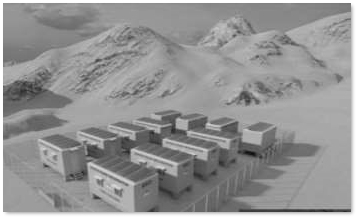
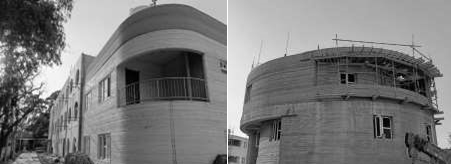
- Green Construction. BRO has co-opted environmental conservation practices in an institutionalised manner into the scope of its infrastructure projects thereby considerably extenuating the adverse ecological consequences of road construction activities. Few examples are given below:
- Use of Steel Slag in lieu of aggregate in Arunachal Pradesh. o Use of Plastic in road construction in a big way.
- Use of Geo textiles, Hydro Seeding, Bio Mass as slope stabilisation techniques on roads.
- Use of Cut and Fit Technology at Panging in Arunachal Pradesh thereby all components of road from drains, breast walls, pavement members etc to be pre casted and fitted at location. o Energy Efficient Buildings at Leh. o Carbon Neutral Habitat at Hanle. o Use of Green Diesel in collaboration with IOC. o Use of pre fabricated culverts in Ladakh.
- Mobile Containerized Accommodations. Snow clearance has been one of the major tasks by BRO in the border areas to facilitate the movement of security forces and their logistic requirements. Mobile containerized accommodation is a prefabricated container mounted on a vehicle and it serves as moving shelter for persons working under harsh climatic conditions, thus reducing the movement of men and machine to detachments/nearest units and increasing efficiency. It is fitted with heating arrangements to provide immediate relief from harsh winters. Snow clearance of LehManali highway was completed using this mobile accommodation, due to which snow clearance operations could be completed in faster time and with enhanced safety.
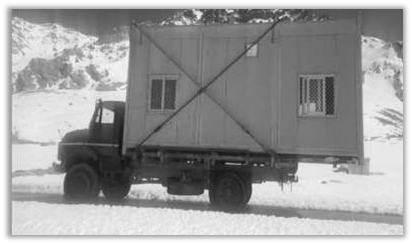
- Induction of New Equipment/Vehicles. Many new generation equipment/vehicles have been identified for induction post Galwan to achieve better efficiency in BRO.
- Tele-Operated Dozer. A remotely operated Dozer BD-50 developed by CVRDE/DRDO is under the process of induction. It is equipped with Human Machine Interface (HMI) which can be carried out by any person or mounted on any B-vehicle. It will certainly reduce the casualty rate during formation cutting in most treacherous locations.
- Direct Methanol Fuel Cell (DMFC). DMFC is a green energy power generating device which converts chemical energy to electrical energy by using Methanol as the fuel. It has extremely low fuel consumption and will lead to major savings in fuel and related costs of logistics.
- JCB Tele-handler. JCB Tele-handler machine is highly manoeuvrable equipment with a Telescopic Boom which can be fitted with numerous attachments at its end to enable several operations at extended height or reach with requisite safety and ease. The tele-handlers have huge applications in road construction and tunnelling operations as multi-utility construction equipment.
- Super Long Front Excavator. BRO has gone for 12 numbers, 65 Ton super long front excavators with 23.5 m long boom as a replacement of vintage draglines, which has been specially made by TATA Hitachi for BRO.
- Other Multi tasking Equipment. Equipment such as multi utility tractors, spider excavators, flat bed trucks, self loading concrete mixers, backhoe loaders with concrete mixture etc have been inducted to achieve economy of resources. BRO has ensured adoption of multitude of innovative technologies, which are environment friendly and safe, during last 3-4 years. The priority for BRO now is construction of robust and maintenance free roads. There would be compelling requirement of dedicated R&D with special focus on permafrost soils in Ladakh and regions with heavy rainfall conditions.
Infusion of Niche Technologies
BRO is presumably the only Government organisation which has prepared and published ‘BRO VISION 2047’, its vision document to cover the period of Amrit Kaal.26 In envisioning future development and reforms, several strategic initiatives, including infusion of niche technologies, have been suggested to enhance the construction capabilities of BRO.
Given the increasing complexity of modern warfare and the strategic challenges posed by China along LAC, it is imperative for the BRO to leverage niche technologies to enhance its capabilities. By integrating advanced technologies such as additive manufacturing, smart materials, sensor fusion, big data analysis, 5G/6G networks, the Internet of Military Things (IoMT), artificial intelligence (AI), quantum computing and green construction, the
BRO can significantly improve its efficiency, effectiveness and synergy with the Armed Forces in joint war-fighting scenarios.
- Additive Manufacturing. Additive manufacturing or 3D printing can revolutionize the way the BRO constructs and maintains infrastructure. An initiative has already been taken in this direction by constructing world’s largest 3D printed complex at Chandigarh to support construction of various strategic projects in Ladakh on mission mode. Also, Cut and Fit technology pilot project has successfully been undertaken to prove that use of pre cast components would revolutionise road construction not only by saving time and costs but also reduce carbon footprint in the fragile ecosystems of Himalayan ranges.
- Smart Materials. Smart materials have properties that can change in response to environmental conditions, offering numerous benefits for the BRO. These materials can repair minor damage on their own, extending the lifespan of roads and bridges and also reducing maintenance costs. Smart materials can adapt to changing conditions, such as temperature fluctuations or mechanical stresses, increasing the strength and longevity of border infrastructure. Adoption of such technology by BRO would certainly transform the work culture and practices in field thereby making its field units more effective and efficient.
- Sensor Fusion. Through sensor fusion BRO can increase situational awareness and decision-making in various ways at its most challenging construction locations. By integrating data from satellite imagery, ground-based sensors and UAVs, the BRO can monitor its work along LAC in real-time. This capability is crucial for assessing road conditions and planning critical construction activities. This fusion can also assist in evaluating weather and terrain conditions to simplifying designing and maintaining roads and bridges in remote locations.
- Big Data Analysis. Big Data analysis can be utilised to analyse historical data obtained from various sources to discern patterns and trends thereby predicting future challenges to enable efficient execution process through right climatic windows by optimisation of men, machines and materials on work sites. Advanced analytics would be able to support decision-making by providing actionable information into factors such as terrain suitability, risk assessment, and project prioritization.
- 5G/6G Networks. BRO small detachments are sprung all along our land borders involved in construction and maintenance activities at remotest locations. Nextgeneration communication networks such as 5G and 6G can significantly enhance BRO’s operations by providing backward and lateral real-time communications to these small detachments thereby reducing the risk factor to BRO Karmyogis working in harshest conditions. Such networks would also support telemedicine centres recently introduced by BRO in far flung areas. Three such centres were inaugurated by Hon’ble Raksha Mantri on 03 Jan 23 from Siyom in Arunachal Pradesh, located at remote and difficult locations of Project Vartak, Pushpak and Himank.27
- Internet of Military Things (IoMT). The IoMT enabled roads, bridges and tunnels would be able to monitor their own condition and report any discrepancies in realtime, reducing the need for manual inspections and enabling proactive maintenance. IoMT devices can track the location and status of construction equipment, materials and personnel, improving logistics and optimising dynamic allocation of all kind of resources thereby cutting down on costs and construction time considerably.
- Artificial Intelligence (AI). AI can revolutionize the BRO’s operations by automating complex tasks of infrastructure planning, enhancing decision-making and improving predictive maintenance activities. Such initiative would not only make construction activities seamless but ensure reduction of downtime of machines and extend lifespan of roads and bridges. AI can also analyze surveillance data to predict natural calamities like landslides and avalanches to prevent loss of precious lives and damage to roads.
- Quantum Computing. Quantum computing can ensure significant benefits for the BRO in optimising resource allocation and construction schedules thereby cutting on project slacks and ensure avoidance of cost and time overruns. It can also assist in studying the terrain data to develop better quality and durable infrastructure along the borders.
Dignity and Social Security to CPLs
BRO employs approximately 70,000 casual paid labourers (CPLs) whose efforts are pivotal in executing the daunting tasks in inhospitable terrains. In a transformative move to uplift the living standards of CPLs, the organisation has provided an array of amenities designed to cater to both their professional and personal well-being. Prefabricated shelters, Porta Cabins, and Bio Toilets have been introduced to improve living conditions. Recognising the extreme weather they often face, the BRO has equipped CPLs with Super HighAltitude Clothing, while recreational facilities have been established to bolster morale, leading to increased productivity and the ability to work for extended periods.
This comprehensive welfare approach was bolstered by a landmark decision in January 2024, when the Raksha Mantri approved a term insurance scheme for CPLs. Additionally, in September 2023, a policy was introduced to repatriate the mortal remains of deceased CPLs to their native places and cover funeral expenses, alleviating the burden on their families. Also, Raksha Mantri has approved a proposal to waive the requirement of completing 179 days at the time of accident for the payment of ex-gratia lump sum compensation to CPLs working in BRO. The combined effect of these welfare initiatives has been substantial, fostering a sense of dignity and security among CPLs.
Conclusion
BRO is an essential component of Indian Armed Forces, playing a crucial role in reinforcing Indian joint war-fighting capabilities, specifically in the context of potential conflicts with China. Through constant upgradation and maintenance of strategically critical border infrastructure, BRO facilitates swift movement of troops and switching of formations at the point of conflict to ensure moral ascendency, effective dominance and sustenance of military operations in the most harsh terrains and climatic conditions. Its contributions to quick military response supported by sustained logistics, force multiplication and decisive strategic extension to joint war-fighting mechanism are pivotal for maintaining an operational edge in high-altitude and remotely spaced conflict situations. Here are certain specific recommendations to facilitate the acquired momentum by BRO and assist it to further accelerate the development of infrastructure on our Northern borders to offset the existing roadhead differential in next 5-6 years.
There is a need for financial reforms in the BRO to ensure incremental fund flow and their efficient utilisation. This would involve greater budgetary oversight, improved financial management practices and better monitoring and evaluation of ongoing projects. There is compelling need to revise existing archaic norms for authorisation of equipment and allotment for funds for procurement of machines to undertake ensuing works. Infact the power to decide the type of equipment and machines required to undertake the strategic works should be delegated to the DGBR to avoid delays in prevalent procurement cycle.
The new technology and products not only enhance the quality of projects but also reduce time of construction and long term costs. There is a need to look at this aspect with open mind in the larger national interest while creating strategic roads and other projects. The BRO workforce needs to be equipped with the necessary skills to operate modern equipment effectively and adopt the latest technologies and construction methodologies to ensure effective execution of strategic works specially tunnels.
BRO is an integral part of Indian Armed Forces under Article 33 of the Indian Constitution and BRO is also probably the only uniformed organisation which is not governed by an exclusive Act. GREF cadre is governed by CCS (CCA) Rules, 1965; whereas Army component of the organisation is dealt by Army Act, 1950 and Army Rules, 1964. It is strongly recommended that BRO Act should be brought in for curtailing anomalies in the pay structure, to deal with disciplinary cases in just and fair manner and bring in more transparency and accountability in functioning of BRO towards Nation building. There have been too many agencies constructing roads in the same space. Such arrangement creates confusion of duplication of connectivity due to lack of inter-ministerial coordination and final accountability of poor quality or speed of work as at time 3-4 agencies are allotted patches of stretch on the same road. It is recommended that there should be “One Border- One Agency” policy promulgated to have clear demarcated areas of operation. Till that happens at least we must ensure “One Axis – One Agency” principle to ensure speed and accountability. Also roads built by BRO should not be handed over to state PWDs but continued to be maintained by BRO itself.
There is an urgent need to create a foreign wing of BRO to enable it to undertake infrastructure projects in friendly foreign countries to establish sub regional connectivity to promote trade, commerce and strengthening diplomatic ties. The government plans to set up BIMA for planned and comprehensive development of infrastructure on borders. One of the aims is to enhance the ongoing development of specific areas by increasing public-private partnership (PPP) and allocation of funds for completing works.28 BIMA can be created initially as one of the verticals of BRO, because of a robust structure already existing at its Headquarters in Delhi. Subsequently it can be moved directly under MoD, to facilitate better and seamless integration with stakeholder ministries.
As border tensions continue to shape our continued deployment all along LAC, the BRO’s role in strengthening security matrix and supporting joint military operations will remain preeminent. Post Galwan conflict, the BRO has embraced several niche technologies in its construction methodology. These advancements have not only enhanced construction quality but also expedited project timelines and ensured sustainability in environmentally sensitive areas. Integrating these newly adopted techniques and other niche technologies with joint war-fighting efforts by the Armed Forces will ensure that India is better prepared to address the strategic challenges posed by China and to maintain the security and integrity of its borders.
DISCLAIMER
The paper is author’s individual scholastic articulation and does not necessarily reflect the views of CENJOWS. The author certifies that the article is original in content, unpublished and it has not been submitted for publication/ web upload elsewhere and that the facts and figures quoted are duly referenced, as needed and are believed to be correct.
*This paper was originally published in CENJOWS SYNERGY Journal [Vol 3 Issue 2] Aug 2024 Edition.
ENDNOTES
- Brig (Dr) Pathak, Ashok (Retd). “India ChinaBorder Dispute Packets of Information to Continuous Spectrum”. Vivekanand International Foundation”, January 27, 2023.
- Junaid, Khola. “Emerging Technologies and their Impact on Warfare”. Modern Diplomacy, June 11, 2024. 3 Kumar, Bhaswar. “Indian Military Theaterisation plans gather Pace…”. Business Standard, May 15, 2024.
- Lt Gen Chaudhry, Rajeev (Retd). “BRO : Looking Ahead, Going Beyond”. Indian Aerospace & Defence Journal, May 2024, pp 20-26.
- Maj Gen Chaturvedi , Ajay Kumar(Retd). “Infrastructure Development as a Force Multiplier”. Vivekanand International Foundation, November 04, 2020.
- Lt Gen Chaudhry, Rajeev (Retd). “Border Roads Organisation: Strategic Surge in Infrastructure”. Destination India, May 2024, pp 52-55.
- Lt Gen Chaudhry, Rajeev (Retd). “BRO : Looking Ahead, Going Beyond”. Indian Aerospace & Defence Journal, May 2024, pp 20-26.
- Lt Gen Chaudhry, Rajeev (Retd). “Surging Surface Infrastructure in Border Areas: Necessity as well as Asset for the Nation”. Centre for Joint Warfare Studies, Issue Brief, April 08, 2024.
- Mohan, Vijay. “BRO to employ Drones for faster, accurate Geological Survey in Road Construction”. Tribune, October 07, 2023.
- Lt Gen Chaudhry, Rajeev (Retd). “Surging Surface Infrastructure in Border Areas: Necessity as well as Asset for the Nation”. Centre for Joint Warfare Studies, Issue Brief, April 08, 2024.
- Singh, Rahul. “India moves to secure Key Flashpoint at LAC”. Hindustan Times, September 29, 2023.
- Choubey, Jitendra. “Steering Connectivity and Inclusion on the Frontiers”. Geospatial World, October 18, 2022.
- Dighe, Sandeep. “Border Roads Organisation Blazes a Trail in most Testing Conditions”. Times of India, November 18, 2022.
- Manta, Dipender. “Soon, Avalanche Protection Structures near Atal Tunnel”. Tribune, June 27, 2021.
- Choubey, Jitendra. “Steering Connectivity and Inclusion on the Frontiers”. Geospatial World, October 18, 2022.
- Dighe, Sandeep. “Our Focus is on Strategic Roads on Indo-China Border: BRO Director General Lt Gen Rajeev Chaudhry”. Times of India, May 07, 2023.
- Singh, Mayank. “More Boost for Infrastructure Development along LAC as BRO aims to make roads sturdier”. New Indian Express, August 23, 2022.
- Natam, Karda. “BRO Spearheading Road Construction along LAC”. Arunachal Times, January, 2021.
- Faridi, SA & Maria, R. “Everything is Possible through Hard Work”. NBM&CW Magazine, March 2023. 20 “GRSE to Build 30 Modular Steel Bridges”. Times of India, May 10, 2023.
- Deb, Pinki & Singh, K Lakshman. “Mix Design, Durability and Strength Enhancement of Cold Mix Asphalt: A State-of-the-art Review”. Innovative Infrastructure Solutions, February 2022.
- Faridi, SA & Maria, R. “Everything is Possible through Hard Work”. NBM&CW Magazine, March 2023.
- Global Slag Staff. “Indian Border Roads Organisation using Steel Slag to Build Roads near Border with China”. Global Slag News, September 29, 2023.
- Team India Sentinels. “BRO’s First Carbon Neutral Habitat in Ladakh…”. India Sentinels, October 28, 2022.
- Goyat, Ramesh. “The World’s Largest 3D Concrete Printed Campus Built by BRO and L&T at Chandigarh”. Daily Guardian, September 25, 2023.
- Lt Gen Chaudhry, Rajeev (Retd). “BRO : Looking Ahead, Going Beyond”. Indian Aerospace & Defence Journal, May 2024, pp 20-26.
- Shukla, Ajai. “Rajnath Singh dedicates Rs 724 Crore Infra Projects to the Nation”. Business Standard, January 03, 2023.
- Times of India, “Eye on China, Govt plans Border Infra Management Authority”, May 02, 2022.

Lt Gen Rajeev Chaudhry, VSM (Retd)
Lt Gen Rajeev Chaudhry, VSM (Retd) on 30 Sep 2023 after 40 years of selfless service in Army. During his last assignment of DGBR for three years, he doubled the pace of work to meet stringent targets post Galwan clash and worked to get an incremental budget allocation of 160% for GS roads. He was honoured with Award of Construction World Person in Year-2021, CIDC Vishwakarma Award for Year 2022 and Institution of Engineers India Eminent Engineer Award for Year 2023 for his exemplary contribution towards infrastructure development on our land borders. He brought transparency in expenditure through increased use of GeM and ensured timely payments to the firms (90% of payments were made within nine days) for which BRO was awarded Gold Certificate for two consecutive years.

